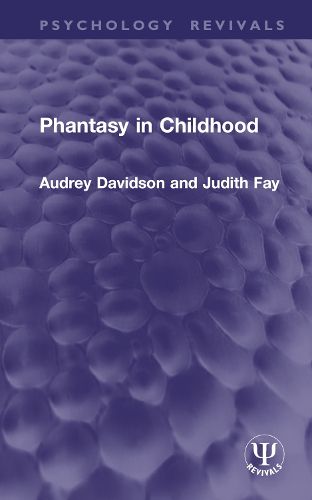Readings Newsletter
Become a Readings Member to make your shopping experience even easier.
Sign in or sign up for free!
You’re not far away from qualifying for FREE standard shipping within Australia
You’ve qualified for FREE standard shipping within Australia
The cart is loading…






First published in 1952, Phantasy in Childhood is for a psycho-analytically oriented public. The authors have set out to express in non-technical language some of the theories we owe to the work of Melanie Klein, and to show how they are repeatedly borne out in the day-to-day behaviour of children. Numerous practical examples are given, drawn from experience of children under many different conditions. In some cases the authors merely suggest interpretations which seem likely, but would need psychoanalytic confirmation; in others the meaning is unmistakable from the material available; in all, the aim has been to point to the presence and nature of unconscious phantasy, and to its expression in behaviour. Although written in simple language, the book is not easy, as, to those who are unfamiliar with it, the concept of unconscious phantasy is in itself difficult. The attempt has been made, however, to give living pictures of the children, and, while definitely not advocating the wild application of a psycho-analytic technique, to show how some understanding of the importance of phantasy can be of value to those caring for children.
This book is a re-issue originally published in 1952. The language used is a reflection of its era and no offence is meant by the Publishers to any reader by this re-publication.
$9.00 standard shipping within Australia
FREE standard shipping within Australia for orders over $100.00
Express & International shipping calculated at checkout
First published in 1952, Phantasy in Childhood is for a psycho-analytically oriented public. The authors have set out to express in non-technical language some of the theories we owe to the work of Melanie Klein, and to show how they are repeatedly borne out in the day-to-day behaviour of children. Numerous practical examples are given, drawn from experience of children under many different conditions. In some cases the authors merely suggest interpretations which seem likely, but would need psychoanalytic confirmation; in others the meaning is unmistakable from the material available; in all, the aim has been to point to the presence and nature of unconscious phantasy, and to its expression in behaviour. Although written in simple language, the book is not easy, as, to those who are unfamiliar with it, the concept of unconscious phantasy is in itself difficult. The attempt has been made, however, to give living pictures of the children, and, while definitely not advocating the wild application of a psycho-analytic technique, to show how some understanding of the importance of phantasy can be of value to those caring for children.
This book is a re-issue originally published in 1952. The language used is a reflection of its era and no offence is meant by the Publishers to any reader by this re-publication.